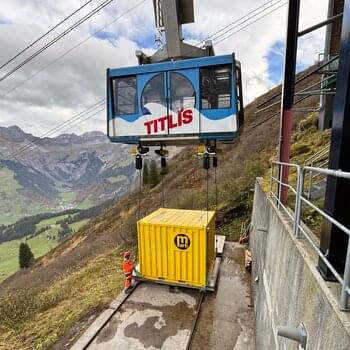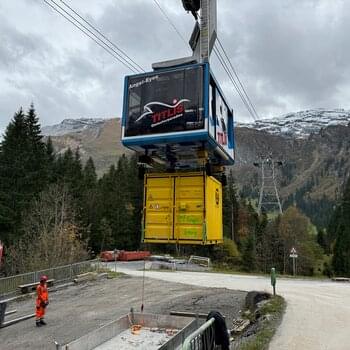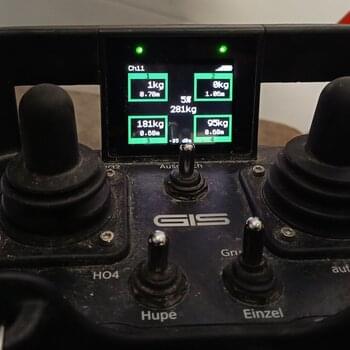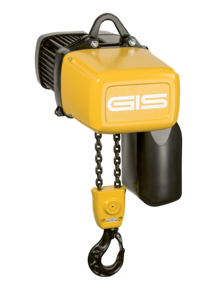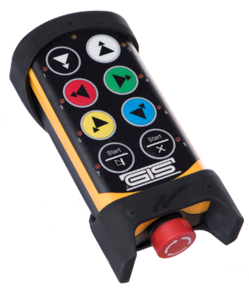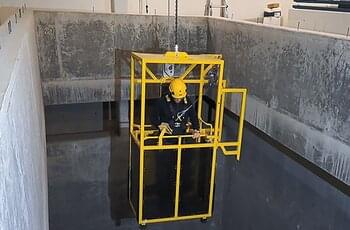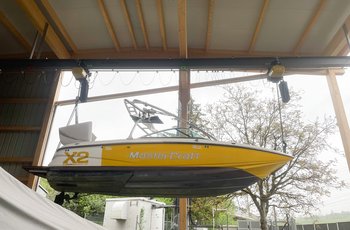With its peak over 3000 metres high, the Mount Titlis is one of Switzerland's most internationally renowned excursion destinations and attracts tourists from all over the world. In view of the constantly increasing number of visitors, the mountain station built in 1967 is slowly reaching its capacity limits. Bergbahnen Engelberg-Trübsee-Titlis AG has therefore launched an extensive construction project. The first step will be to extend the directional radio tower for tourist use and then replace the mountain station with a new building by 2029. The aim is to massively improve the ecological sustainability of the infrastructure and create new opportunities for catering, hospitality and events. An important milestone in the project is the commissioning of the new ‘Titlis Connect’ single-track aerial cable car to connect the Stand station with the Titlis, parallel to the existing Rotair cable car. It is scheduled to go into operation at the beginning of 2025 and will be used primarily for transporting materials during the construction phase, and later also for passenger transport.
Freight transport with the aerial cableways
The challenges of such a major project are manifold. One of these concerns the transport of building materials and equipment up the mountain. In addition to helicopter flights, this is mainly carried out by cable car from spring to autumn. The goods are first brought to Gerschnialp above Engelberg by lorry and then transferred from there by cable car. The aerial tramways transport the loads in several stages to Trübsee, on to the station Stand and finally to the summit of the Titlis. The goods can be transported both in the cabin and under the gondola, but always separately from the tourist passengers. In order to meet the requirements of the construction project, each of the three cable car compositions involved received a new underload transport system from GIS called ULC (underfloor loaded cabin) in spring 2024. It consists of four chain hoists that are mounted on the underfloor of the cabin and to which containers, barrels and other loads can be attached.
Electronic assistants to support the operator
To pick up the goods, the gondola is positioned outside the mountain station above the prepared material. The load strands of the four hoists are lowered and the transport goods are hooked onto the safety load hooks. With the activated synchronisation of the electric chain hoists, the container is then gently pulled up to the cabin. Close to the gondola, the hoists first switch from fast to slow lifting speed before stopping in the pre-programmed end position. An operator monitors and controls the entire lifting process via a radio remote control. The electric chain hoists can be operated individually or together as a group, whereby the operator can see the loads of the chain hoists and the position of the load hooks in real time on the display of his hand-held transmitter. Additional controls can be used to adjust all chain strands to the height of the top or bottom hook and to balance the load. These safety functions have proved particularly useful on the Rotair railway between Stand and Titlis. Not only are transports from station to station carried out here, but also regularly in open terrain with lifting heights of up to 35 metres. Especially at night or in fog, when the load is not always visible to the operator, he must be able to rely on the electronic assistance systems and the information on the display.
Control system ensures increased safety
The GIS underload transport system fulfils the safety requirements of EN 14492-2 and IGW SQP2 (holding loads above people) and offers increased safety during loading and unloading as well as during the journey, which runs over numerous hiking trails and crosses another ropeway at one point. It consists of four GP1600 GIS electric chain hoists and a mobile control unit. The chain hoists are connected to the control unit by cables, which are used for both power supply and data transfer. This control unit travels on a trolley in the gondola and is the brain of the transport system, as it controls and monitors the chain hoists. In consultation with the cable car manufacturers, a safe working load was defined, which must be prevented from being exceeded by the monitoring software, as well as the overloading of an individual chain hoist due to uneven weight distribution of the transported goods. At the end of the shift, the control system can be disconnected in just a few minutes to prepare the cabin for passenger transport.
Interruption-free operation is of great importance
When Titlis Bergbahnen approached GIS AG, the manufacturer of electric chain hoists and crane systems, at the start of the project, there were clear requirements that had to be realised with the supplied underload transport units. In addition to the safety aspects of multi-shift operation and changing operators, the ULC system ensures optimum utilisation of the cabin payload and therefore extremely efficient material transport. No significant modifications to the gondolas were required for the integration, as the existing devices of the old systems could also be used for the new ones.
Interruption-free operation is of great importance, not only during the construction phase. GIS electric chain hoists have proven themselves over many years of hard use. The modular design of the units also ensures that the chain hoists and control systems can be used on all three routes, which enables rapid replacement of equipment and short response times in the event of faults or maintenance work. Based on the positive experience gained, it is planned to equip the Titlis Connect, which will go into service in a few months, with a GIS underload transport system as well.
Technical data / fact sheet
- The three aerial cableway sections Gerschnialp-Trübsee, Trübsee-Stand and Stand-Titlis have a new system for underload transport. It is planned that the ‘Titlis Connect’ cable car, which is currently under construction, will also be equipped with such a transport system.
- The underload transport system consists of 4 hoists (GP1600 electric chain hoist) and a mobile control unit. This transport unit is operated by radio control.
- The control unit is mobile and is located on a transport trolley to be carried in the gondola. It takes over the power control of the hoists as well as the monitoring functions. The radio receiver and the power supply are attached to it and it has a display on which the operating information is shown in the same way as the radio transmitter. However, the transport system is only operated with the hand-held transmitter of the radio control or, if necessary, with a plug-in emergency control switch.
- The hand-held transmitter for radio control has 2 joysticks, one for the drive commands and one for selecting and deselecting the lifting units. Toggle switches are used to switch from individual to group operation, trigger the tare function to equalise the hook positions and activate the horn. A display provides the operator with information on the current hook positions, loads and operating states of the hoists.
- GIS electric chain hoists type GP1600 are used as hoists for a maximum lifting height of 35 m and with two lifting speeds (8/2 m/min). The hoist motor is equipped with thermal overload protection. The devices have a second brake as a secondary safety element if the normal holding brake fails and a geared limit switch for the top and bottom hook position. Components for electronic load and travel measurement are installed. The load is picked up by safety load hooks.
- The permissible safe working load of the underload transport systems were determined in consultation with the cable car manufacturers and their compliance was monitored by the mobile control system.
- During normal operation of the transport system, the hook position and load of each individual chain hoist and the entire group are monitored. When close to the cabin, the system automatically reduces to the slower lifting speed and then stops. The taring function can be used to angle the load hook positions to each other in order to align the transported goods horizontally.
- There is a role concept for users with authorisations for the various operating modes. The operating mode of the mobile control unit can be switched from normal to emergency mode using a safety key, thus deactivating the electronic monitoring functions. The direct, mechanical overload protection remains active in accordance with EN14492-2, as does the gear limit switch for the lowest and highest hook position.
- The lifting units are connected to the mobile control unit via a plug-in interface. The cable is used for power supply and data transfer. The connectors are designed in such a way that the linkages cannot get mixed up when connected to the control unit.
- The transport system is designed for holding loads above people in accordance with the EN 14492-2 standard and the D8+ standard in accordance with IGVW SQP2 and is based on the Machinery Directive 2006/42/EC. The control system fulfils the safety requirements of EN 13849 and tandem operation is monitored in accordance with EN 15011.

